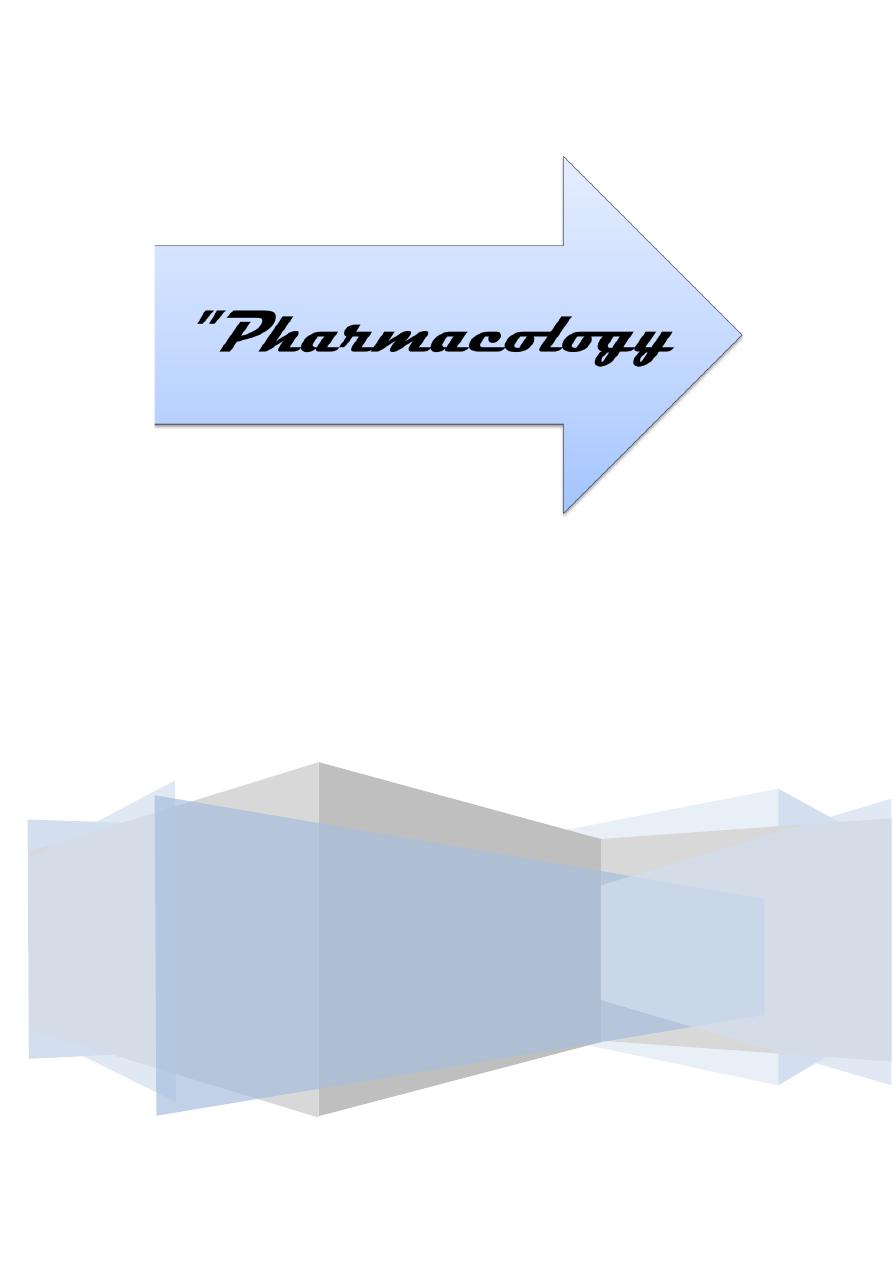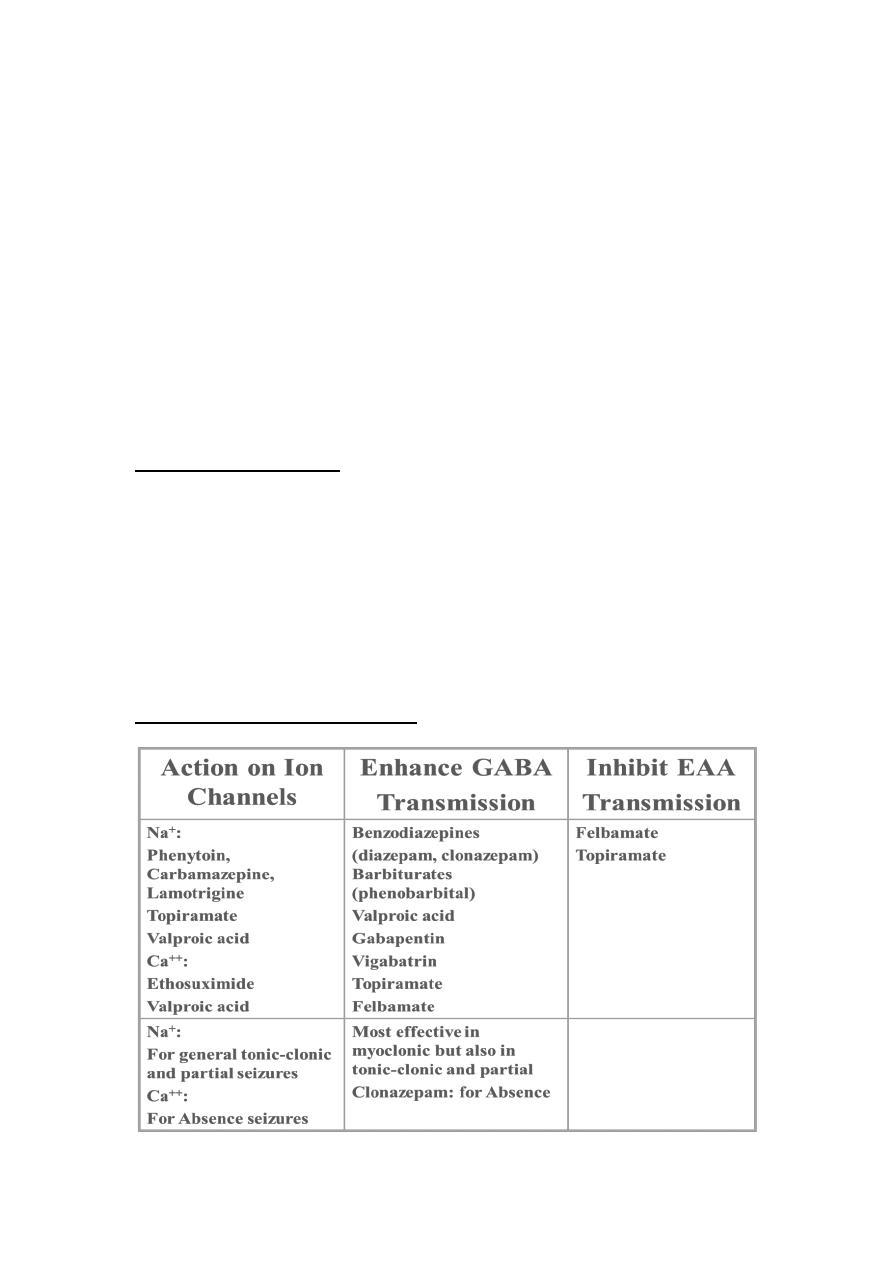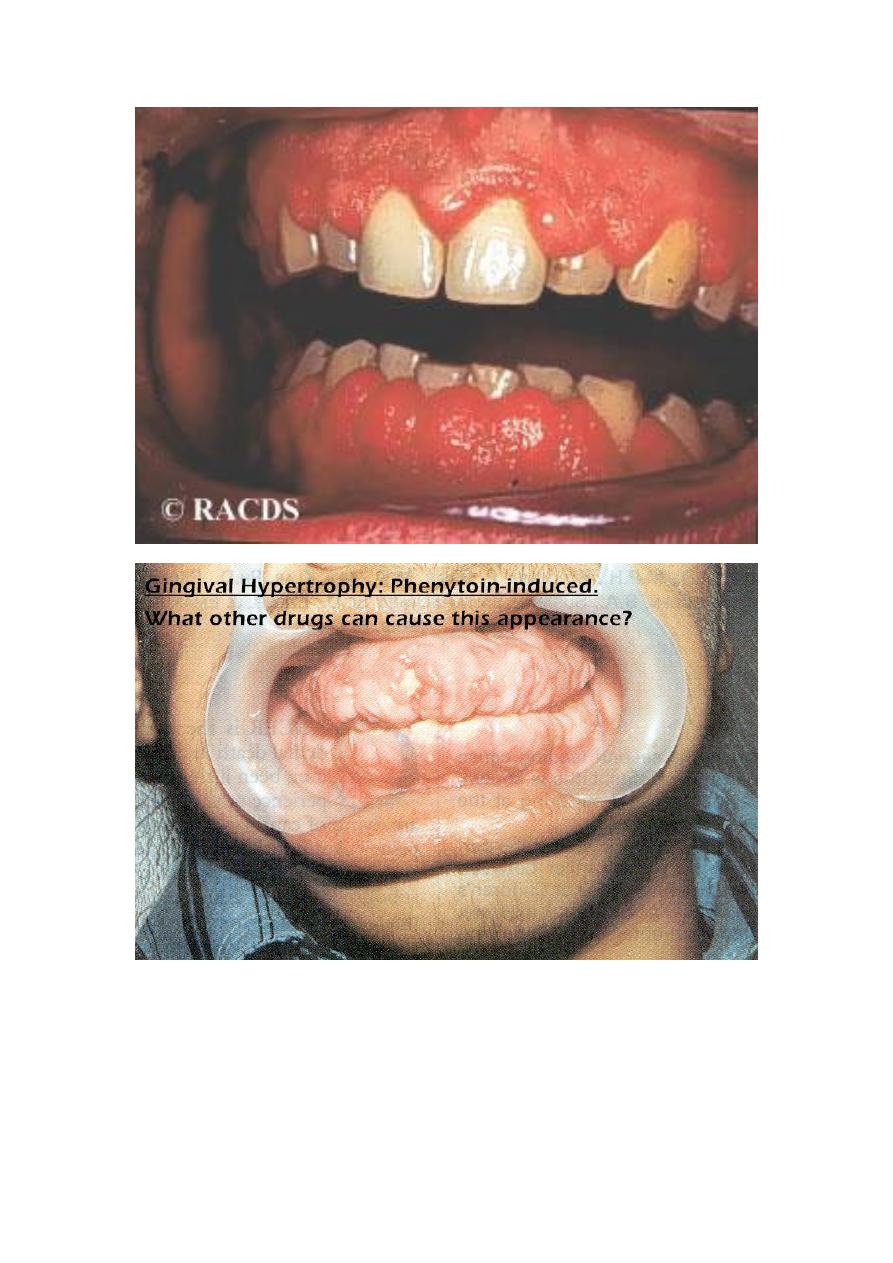
Sunday 15 / 2 / 2015
©Ali Kareem 2014-2015
Name
:
______________________________
Class
:
_______________________________
مكتب اشور لالستنساخ
ANTI-EPILEPTIC DRUGS
Lecture 5
Total lectures NO. 35
Dr. Naseer Al-Harchan

2
ANTI-EPILEPTIC DRUGS
Introduction
Seizure
• Seizures are sudden, transitory, and uncontrolled episodes of
brain dysfunction resulting from abnormal discharge of neuronal
cells with associated motor, sensory or behavioral changes.
Epilepsy
• A group of chronic CNS disorders characterized by recurrent
seizures.
Classification of Epileptic Seizures
I. Partial (focal) Seizures
A. Simple Partial Seizures
B. Complex Partial Seizures
C. Partial with secondary generalized tonic classic seizure
II. Generalized Seizures
A. Generalized Tonic-Clonic Seizures
B. Absence Seizures
C. Myoclonic Seizures
Pathological Basis
Abnormal electrical discharge in the brain

3
Coordinated activity among neurons depends on a controlled
balance between excitation and inhibition
Any local imbalance will lead to a seizure
Imbalances occur between glutamate-mediated excitatory
neurotransmission and gamma-aminobutyric acid (GABA)
mediated inhibitory neurotransmission
Generalised epilepsy is characterised by disruption of large scale
neuro-networks in the higher centres.
Strategies in Treatment
• Stabilize membrane and prevent depolarization by action on ion
channels
• Increase GABAergic transmission
• Decrease EAA (Excitatory Amino Acid) Transmission
Classification of Anticonvulsants

4
Classical
• Phenytoin
• Phenobarbital
• Primidone
• Carbamazepine
• Ethosuximide
• Valproic Acid
• Trimethadione
Newer
• Lamotrigine
• Felbamate
• Topiramate
• Gabapentin
• Tiagabine
• Vigabatrin
• Oxycarbazepine
• Levetiracetam
• Fosphenytoin
• Others
Phenytoin
• Limited water solubility – not given i.m.

5
• Slow, incomplete and variable absorption.
• Extensive binding to plasma protein.
• Metabolized by hepatic ER by hydroxylation. Chance for drug
interactions.
• Therapeutic plasma concentration: 10-20 µg/ml
• Shift from first to zero order elimination within therapeutic
concentration range.
Phenytoin – Toxicity and Adverse Events
Acute Toxicity
• High i.v. rate: cardiac arrhythmias ± hypotension; CNS depression.
• Acute oral overdose: cerebellar and vestibular symptoms and
signs:
nystagmus, ataxia, diplopia vertigo.
Chronic Toxicity
• Dose related vestibular/cerebellar effects
• Behavioral changes
• Gingival Hyperplasia
• GI Disturbances
• Sexual-Endocrine Effects:
– Osteomalacia
– Hirsutism
– Hyperglycemia

6
Chronic Toxicity
• Folate Deficiency - megaloblastic anemia
• Hypoprothrombinemia and hemorrhage in newborns

7
• Hypersenstivity Reactions – could be severe. SLE, fatal hepatic
necrosis, Stevens-Johnson syndrome.
• Pseudolymphoma syndrome
• Teratogenic
• Drug Interactions: decrease (cimetidine, isoniazid) or increase
(phenobarbital, other AED’s) rate of metabolism; competition for
protein binding sites.
Carbamazepine (Tegretol)
• Second - most commonly prescribed anticonvulsant
• Structurally related to tricyclic antidepressants
• Uses:
– partial and tonic-clonic seizures
– neuropathic pain management
– Schizophrenia, bipolar disorder
• May be used in combination with Dilantin or Phenobarbital
All types except absence seizures; particularly useful for
generalized tonic-clonic, simple and complex partial
Inhibition of voltage-gated Na
+
channels
Oral, slow and erratic, 75% plasma protein bound; t
1/2
=36 hrs
initially, decreasing to 20 hrs following continuous therapy
(autoinduction), active metabolite excreted
Diplopia and ataxia, GI upset, hypersensitivity, serious toxicity
including aplastic anemia, agranulocytosis
Drug interactions are many, related to the hepatic enzyme
inducing properties of carbamazepine

8
• Toxicity similar to phenytoin
Adverse effects
– CNS:
• Restlessness, irritability, agitation
• Dizziness, confusion, ataxia, encephalopathy
– Renal
• Renal failure, urinary frequency
• Water retention (stimulates ADH)
– Visual changes
• Agranulocytosis
• Lupus
• Arrhythmia & cardiac conduction abnormalities
• Toxicity: bone marrow depression, hepatic dysfunction, visual
changes
• Numerous drug interactions
• Erratically absorbed, better absorption on full stomach
Phenobarbital
• The only barbiturate with selective anticonvulsant effect.
• Bind at allosteric site on GABA receptor and ↑ duration of
opening of Cl channel.
• ↓ Ca-dependent release of neurotransmitters at high doses.
• Inducer of microsomal enzymes – drug interactions.

9
• Toxic effects: sedation (early; tolerance develops); nystagmus &
ataxia at higher dose; osteomalacia, folate deficiency and vit. K
deficiency.
• In children: paradoxical irritability, hyperactivity and behavioral
changes.
• Deoxybarbiturates: primidone: active but also converted to
phenobarbital. Some serious additional ADR’s: leukopenia, SLE-
like.
Valproic Acid
• Effective in multiple seizure types.
• Blocks Na and Ca channels. Inhibits GABA transaminase. Increases
GABA synthesis.
• Toxicity: most serious: fulminant hepatitis. More common if
antiepileptic polytherapy in children < 2 years old. (?) Toxic
metabolites involved.
• Drug interactions: inhibits phenobarbital and phenytoin
metabolism.
Ethosuximide
• Second - most commonly prescribed Drug of choice for Absence.
Blocks Ca++ currents (T-currents) in the thalamus.
• Not effective in other seizure types
• GI complaints most common
• CNS effects: drowsiness lethargy).
• Has dopamine antagonist activity (? In seizure control) but causes
Parkinsonian like symptoms.

01
• Potentially fatal bone marrow toxicity and skin reactions (both
rare)
Benzodiazepines
• Diazepam (Valium) IV, IM
• Lorazepam (Ativan) IV
– Used to terminate status epilepticus
– Close medical supervision & resuscitative equipment should
be available
potentiates GABAA receptor function via a distinct allosteric
binding site on the protein termed the benzodiazepine receptor.
↑ frequency of opening of Cl channel.
diazepam (i.v.)- drug of choice for the treatment of status
epilepticus
clonazepam and clorazepate- long-term treatment of absence,
myoclonic, akinetic and atonic seizures; tolerance to
anticonvulsive action limits clinical usefulness of benzodiazepines
potentiates GABA
A
receptor function via a distinct allosteric
binding site on the protein termed the benzodiazepine receptor
oral, t
1/2
: clonazepam=1 day; clorazepate=2 hrs; i.v. diazepam=1-2
days); very high plasma protein binding, N-desmethyldiazepam
(t
1/2
=3 days) is active metabolite of diazepam and clorazepate,
clonazepam is primarily reduced to inactive metabolites
sedation, ataxia; hyperactivity and irritability in children; high
therapeutic index, low incidence of toxicity
additive or synergistic effects with other sedative hypnotics

00
Enhancers of GABA Transmission
• Gabapentin: Developed as GABA analogue. Mechanism: Increases
release of GABA by unknown mechanism.
• Vigabatrin: Irreversible inhibitor of GABA transaminase. Potential
to cause psychiatric disorders (depression and psychosis).
• Tiagabine: decreases GABA uptake by neuronal and extraneuronal
tissues.
Done by
Ali Kareem
